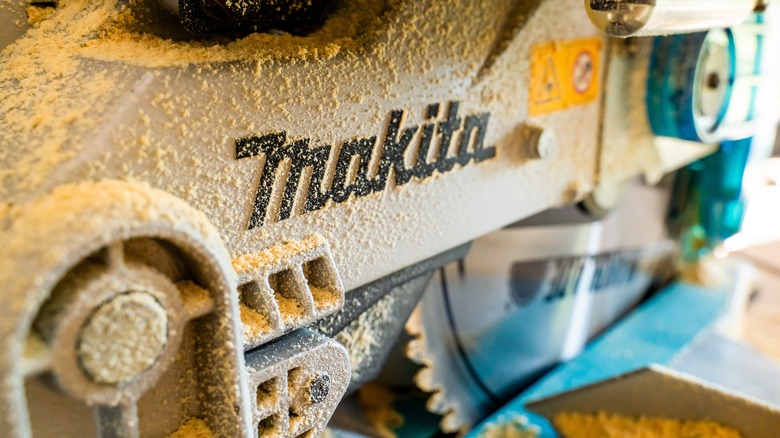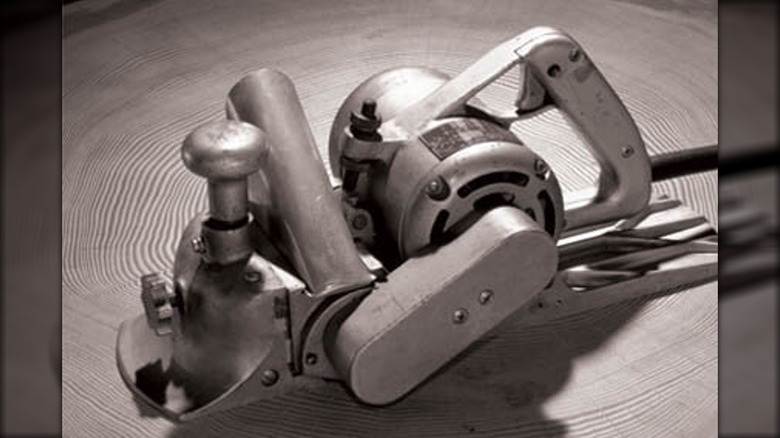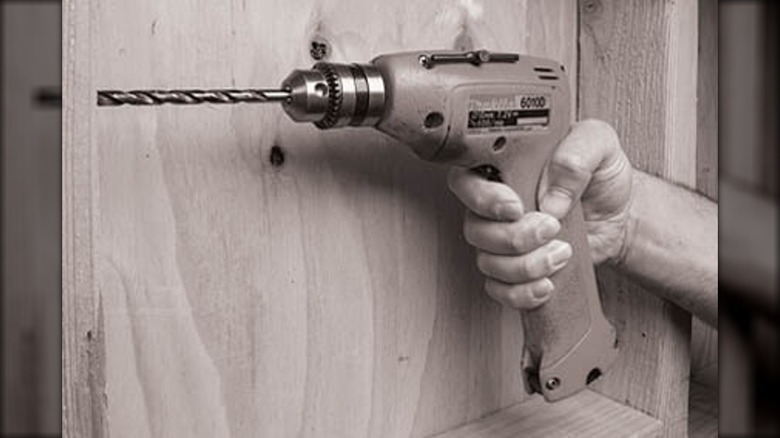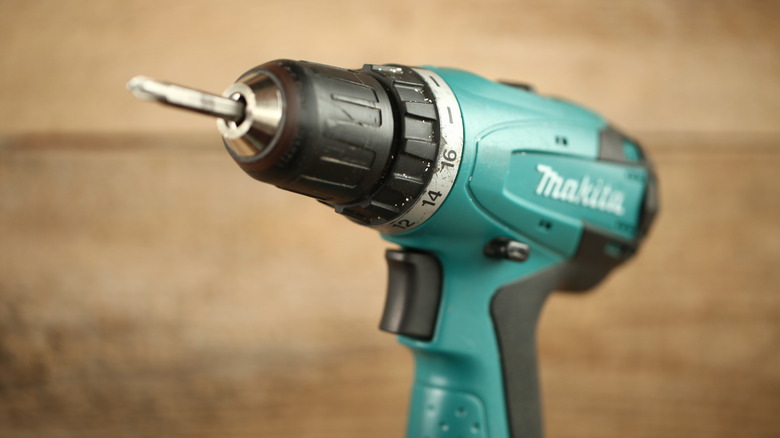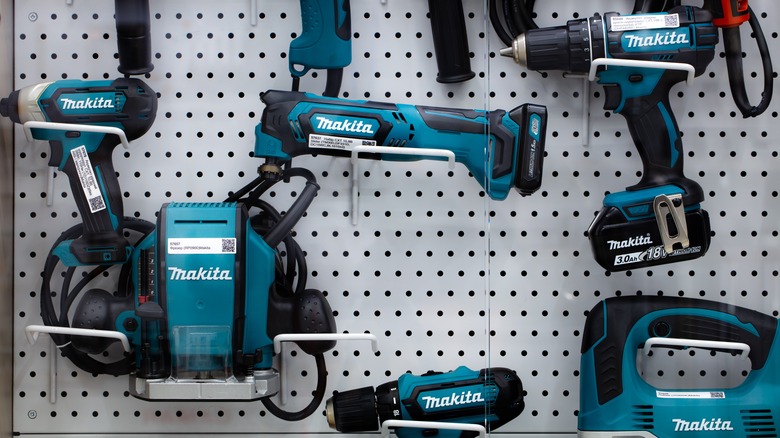The Makita Timeline: A Closer Look At The History Of Makita Tools
Makita is one of the best-known brands in power tools, among other big names like Milwaukee, Black & Decker, Ryobi, and DeWalt. While many of its current products may look and function similarly to those of its competitors — besides the signature teal blue color sported by most of its tools, of course — Makita has traditionally stood out from the rest through its innovation.
Sure, it's one of many manufacturers that make cordless drills and brushless motor impact drivers, but it's the only brand that can say it was the first to put them out on the mainstream market. This innovation is a key characteristic found throughout the history of the company, which dates back more than a century. It's one reason why Makita is still known today for making strange tools that you might find to be very useful in your home and garage.
Additionally, Makita tools are typically well-made and reliable, which is likely rooted in the company's long history of mechanical engineering and repair work. In fact, the company didn't start making power tools until nearly 50 years after its founding. Many Makita tools are also used by both professionals and DIY-ers because they are affordable and won't break the bank. If you're interested in a more detailed account of the manufacturer and its products, here is a closer look at the history of Makita tools and the company that makes them.
The first 45 years
The Makita Corporation known around the world today for making power tools first started as the Makita Electric Works in Nagoya, Japan, when it was officially founded in 1915. Originally, Makita sold and repaired motors, transformers, and lighting equipment. The company expanded 20 years later and its name became more internationally known when it started exporting electric generators and motors to the Soviet Union in 1935. As a sign of its growth, the company became incorporated three years after that and was renamed Makita Electric Works, Inc. Makita continued to operate during World War II, although the conflict led the company to relocate its headquarters to Anjo in 1945.
While these were important years for Makita, it wasn't until 1958 that the company first began manufacturing power tools — something it continues to this day. Its first power tool was a 120 mm electric hand planer, called the Model 1000, a portable device that used electricity to make hand planing a much less labor-intensive task. Makita was the first company in Japan to make and sell electric planers, and it was the beginning of a massive transition toward becoming an electric tool manufacturer. The product was a success, and Makita shipped 1,300 of the handheld tools to Australia in 1959. Makita continues to build and sell electric hand planers to this day.
The next two decades
Makita continued to grow in the 1960s, constructing a new main manufacturing plant at the start of the decade. In 1962, it changed its name to Makita Electric Works, Ltd. and went public on the Nagoya Stock Exchange. Within a year, it was entirely debt-free, and in 1968 — three years after its 50th anniversary — the company expanded to the Tokyo and Osaka stock exchanges.
A year after that, Makita proved to investors it was worth their capital by introducing the 6500D, the world's first widely-marketed rechargeable, battery-operated power tool. The product revolutionized the way professionals and consumers could work on jobsites and at home by giving them the freedom to use powerful motors that reduce labor and fatigue without needing to be close to an electrical outlet. The 6500D was the first of countless types of power tools to be used and sold around the world.
In 1970, Makita built a new facility, the Okazaki Plant, and established Makita U.S.A. Inc. in the United States. It continued expanding internationally throughout the 1970s, establishing companies in France, the United Kingdom, Australia, Canada, the Netherlands, and in Italy between 1971 and 1974. In 1977, Makita stock started trading on NASDAQ while expanding to Belgium and Germany.
As its corporate footprint grew around the globe, Makita continued to innovate in the world of power tools. In 1979, the brand debuted the 6010D 10 mm rechargeable drill, the first power tool to use a removable nickel-cadmium battery — an energy-dense, reliable, and versatile power source for cordless electric tools.
The '80s and '90s
Makita kicked off the 1980s by releasing its pneumatic nailer (the AN5000) and air compressor (AC6001), its first air tools, while expanding to Brazil and Austria. In 1983, it expanded to Singapore and began manufacturing power tools in Canada for the first time.
In 1985, Makita started production of power tools in the U.S. for the first time. As power tools became subject to tariff wars between the U.S. and Japan in the late 80s, Makita established companies in Taiwan and Spain, continuing its international growth. At the end of the '80s, three Makita power tools designed by Giorgetto Giugiaro — famous for his designs of supercars and other vehicles — were exhibited at the World Design Exposition held in Nagoya, Japan. They included a circular saw, grinder, and drill.
The '90s were busy for Makita as well — in 1991 it acquired the German chainsaw manufacturer Sachs Dolmar GmbH, changed its name to Makita Corporation, and began manufacturing power tools in the U.K. Makita continued to expand globally throughout the 1990s, establishing companies in Hong Kong, New Zealand, Poland, Mexico, the Czech Republic, Hungary, the United Arab Emirates, Argentina, Chile, and Greece. It also established a company in China in 1993 and began producing power tools there in 1995.
Towards the end of the century, in 1997, Makita exhibited its first nickel-metal-hydride (NiMH) cordless tool — a rechargeable driver-drill — at the Chicago Hardware Show. The innovative power source is both more powerful and cost-effective than previously used NiCd batteries and doesn't contain environmentally hazardous cadmium.
Makita continues to innovate in the 21st century
Over eight decades old, Makita was still growing at the start of the 21st century, expanding to Romania and Switzerland in 2000. It also established additional companies in China, Europe, and the U.S., as well as one for the first time in Finland, Russia, Slovakia, Ukraine, Peru, Bulgaria, India, Colombia, Morocco, Vietnam, Thailand, Slovenia, Malaysia, and other countries before celebrating its 100th anniversary in 1915. Additionally, Makita built production facilities for the first time in Romania and Thailand in the 2000s and finished construction of its new corporate headquarters in 2003.
In 2002, Makita created a new tool brand, Maktec, marketed specifically toward Asian consumers. Two years later, Makita's Assembly Division created tools with brushless motors for the first time, allowing them to run longer, last longer, and employ increased power and speed — ideal for tools specifically used in precision assembly applications. Eventually, brushless power tools were also marketed to consumers as well.
The battery technology powering Makita tools advanced once again in 2005 when the company launched its first tool powered by a lithium-ion battery, the TD130D impact driver. Lithium-ion batteries are still being used today and are the go-to power source for most contemporary cordless power tools, made by Makita or otherwise. Makita, the domestic market leader for cordless impact drivers at the time, continued to innovate in 2009 by releasing its first 18V model. The state-of-the-art impact driver used a brushless motor and powerful lithium-ion model to give customers its most powerful and easy-to-use cordless impact driver yet.
Today, Makita continues to produce popular long-lasting cordless tools — 18V batteries are still common, and even larger-capacity 40V models are also available. Only time will tell how Makita might further innovate the power tool industry throughout the 2020s and beyond.
